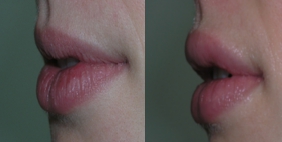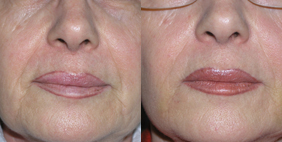- What are implants or facial fillers?
- Types of fill materials
- How long does a facial filler last?
- How is treatment with facial fillers?
- Side Effects
- How much does it cost?
1. What are implants or facial fillers?
Wrinkles are one of the first visible signs of aging.
The different techniques to correct wrinkles generally pursue two objectives: the filling and levelling, and the stimulation of the corrective tissue. This is achieved by introducing injectable materials.
These injectable materials can be reabsorbable (meaning the body destroys them, usually within months) or permanent. We currently have more and better filling materials that allow us to correct facial defects or imperfections as lipodystrophy, chin increase, correcting the oval of the face, etc.
 The fillers are a great option to efficiently, quickly and conveniently correct small wrinkles and skin folds. Also, thanks to this filling technique, the volume and thickness of the lips can be increased, giving them a more turgid and sensual aspect. It also allows the molding of the chin and cheekbones.
The fillers are a great option to efficiently, quickly and conveniently correct small wrinkles and skin folds. Also, thanks to this filling technique, the volume and thickness of the lips can be increased, giving them a more turgid and sensual aspect. It also allows the molding of the chin and cheekbones.
The procedure is quick, safe and virtually painless. It consists of the insertion of small quantities of filler in the skin using a fine needle. Depending on the area to treat, the anaesthesia can be local or topical.
Currently, the most used is hyaluronic acid because; it is a substance present in tissues, it retains and conserves water in the skin, and its production is reduced over the years. It has the advantage of being biodegradable, non-permanent and it doesn’t require skin testing prior to implementation. It is available in different densities for use at various face levels.
Denser molecules are used for the correction of deep furrows and folds or cheek projection. The result subsides slowly, allowing time to make adjustments.
Calcium hydroxylapatite (Radiesse): This is a gel containing suspended particles of calcium hydroxyapatite, a compound similar to calcium phosphate (present in teeth and bones), so it does not cause chronic inflammation or immune response.
As the former material, this one is biodegradable and it is indicated for the same areas except fine wrinkles and lip augmentation.
Aquamid is a transparent, injectable implant composed of 97.5% water, associated with a 2.5% cross-linked polymer (polyacrylamide). It has been specially designed and formulated for the correction of the soft facial tissue: deep creases, wrinkles, nose, chin, lip augmentation and other facial corrections.
Therefore, Aquamid is a solution for lasting aesthetic corrections, adding water to the tissue. The results are immediate and natural. Aquamid is a homogeneous gel without micro particles. It is neither re-absorbable nor allergenic. However, it is biocompatible, physically and chemically stable, resistant to migration, and does not affect the immune system.
3. How long does a facial filler last?
The duration is based on the type of facial filler chosen. These filling substances can be filled permanents (not reabsorbed, remain permanently) or temporary (6 months to 1 year) according to patient preference. In addition, fillers made with hydroxyapatite may have a variable duration, from 6 months to 2 years or even longer.
Their biggest advantage is that it shows amazing results, natural and lasting without changing the expression of the face.
4. How is treatment with facial fillers?
 This treatment is painless and short-term (15 to 20 minutes). A satisfactory aesthetic result is achieved quickly and the patients can immediately resume their daily activities. The intended results are visible immediately.
This treatment is painless and short-term (15 to 20 minutes). A satisfactory aesthetic result is achieved quickly and the patients can immediately resume their daily activities. The intended results are visible immediately.
After treatment, and depending on the reaction of the skin, the patient may experience redness in the area, swelling or tenderness. All of these symptoms are quite normal and they disappear in a few days, or may be camouflaged with makeup. Haematomas may also occur and they disappear in 7 to 10 days.
It always depends on the treated area. If it is a single zone or several, what kind of filling material is used, and the amount needed. After analysing the needs of each patient, we produce a personalised budget without compromise. If you would like a price estimate for the areas you want to treat, please contact us by phone or email.


